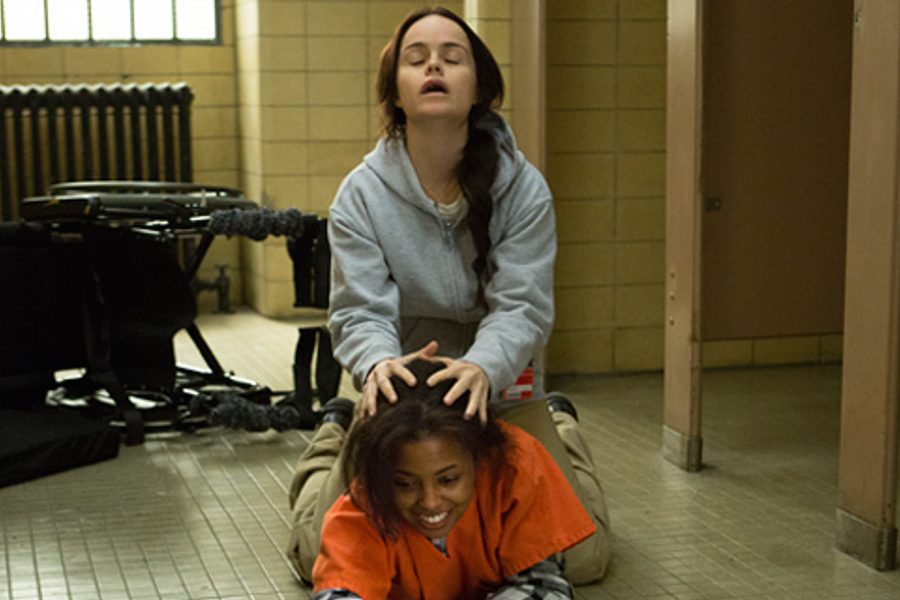Orange Is The New Black, Episode 10: There’s No Place Like ‘Bora Bora Bora’
The fantasy that keeps us going.
Jude Ellison Sady Doyle

On one level, this particular episode title is a stupid throwaway joke: It’s where Morello, never the sharpest knife in the drawer, is planning her honeymoon with her elusive fiancé Christopher because she doesn’t know how to say “Bora Bora.” But on another level, it’s one of the cruelest moments in the series: Nicholls, guilty over having ratted Red out and having finally reached the “how did I ever date you” phase with Morello, points out that the reason Christopher is so elusive is because “Christopher doesn’t exist — not in [Morello’s] life, anyway.”
Christopher, it turns out, abandoned Morello shortly after she was incarcerated. But Morello just keeps talking about him — planning her wedding with him, telling everyone Christopher’s favorite colors and Christopher’s favorite places and what Christopher cooked for dinner that one time — because she has to survive Litchfield somehow. Because believing she has someone out there, some good place to arrive eventually, is what gets her through the day.
Bora Bora Bora is the delusion that keeps you going: It’s the necessary bit of craziness that keeps you sane. It’s the good place you’ve decided you’ll get to one day, no matter what the evidence says about being stuck where you are. If you look closely, almost everyone in this episode is headed to their own Bora Bora Bora. For Alex, it’s the belief that she’s back in a relationship with Piper; for Piper, it’s the belief that she’s not in a relationship with Alex, that this is just a sexy little detour before she gets back to her “good life” with Larry. For Pennsatucky, Bora Bora Bora is being chosen by God, which (due to some effective trickery from Alex) now seems to include faith healing powers. For Bennett, Bora Bora Bora is not facing any consequences for having unprotected sex with Daya, who as an inmate can’t legally consent. And for Tricia, Bora Bora Bora is the idea that she’ll settle her debts one day; that she’s not stealing anything because she’ll pay everyone back when she can pay them, do the right thing, and end her life in peace.
All of these people are wrong. And, to a greater or lesser degree, the lies these people have told themselves will destroy them. This is one of the grimmest episodes of Orange Is The New Black: The episode about how Bora Bora Bora always, eventually, falls apart. No matter how much you need saving, you can’t be saved by something that doesn’t exist.
But, speaking of salvation through lying: This is also the episode that provides some of Orange Is The New Black’s smartest metacommentary through the introduction of the Scared Straight program.
These scenes — in which the inmates relish the opportunity to “scare some bad kids”—rely entirely on the strong groundwork OITNB has done so far with these characters. We understand the hilarity of assuming that characters like the imperturbably reasonable Poussey or Flaca the über-dorky mall-Goth are inherently terrifying just because they’re people of color in prison. We also understand that the account of prison they’re required to give, a good old-fashioned bit of retrograde torture porn — scary, violent people of color threatening little blond girls! “Stone cold” queer people wandering the halls looking for someone to rape! — is both unrealistic and ineffective. We know by now that none of the women in this prison wound up here just because they weren’t scared of prison, and we understand that sensationalizing their suffering or casting them as monsters does very little either to keep people out or to help the people who are already there.
It seems to me that the Scared Straight scenes are a pretty good answer to critics who worry that OITNB glosses over the violence of the prison experience. Their inclusion seems to be a deliberate rejection of torture-porn as consciousness-raising narrative device. At the end of the tour, the inmates are guided into the bathrooms, where all they can do is stand around, trying to sound as ominous as possible, while describing the facilities’ awful conditions. It’s funny enough, especially when the scene devolves into poop jokes. (“You gotta use the bathroom, everybody’ll see it!” “Even if it’s number two!” “One … two … three … it don’t matter, in prison.”) But, by this point, several major plot lines have revolved around the awfulness of those bathrooms. We know that the inmates do hate them; they’re dirty enough to make you physically sick, they comprise a humiliating and dehumanizing loss of privacy and control, and they’re unavoidable. The “dropping a bar of soap” stereotype that a guard invokes for the kids doesn’t illuminate that; it just hides the real pain involved and shuts off a real discussion by insisting on sensationalist gore.
And in the end, the violence of prison is very real — it’s more real, and more graphic, in “Bora Bora Bora” than in any other episode to date. We learn that Tricia, who ran away from home and lived on the street to escape being sexually abused by her stepfather, has been sexually abused continuously by Pornstache for the past 10 months. She’s been forced into a “blow job layaway plan” to avoid the physical agony of heroin withdrawal. Then, Pornstache put her through that agony, on purpose, triggering her withdrawal to coerce Red into joining his operation. And now, Pornstache retroactively says the “blow job layaway plan” wasn’t payment — that she “let” him do all that to her for nothing — because Pornstache needs her to distribute his new shipment. The day after she’s kicked the habit, he abandons her with a bag full of narcotics, which of course she starts using immediately. So finally, Tricia, whose one rule was that she would always pay for everything, that she wouldn’t let a debt stand, and who has been locked in a supply closet by her rapist with a bag full of drugs she’s got to get rid of somehow, swallows the whole batch and dies.
Tricia’s life and death are the most violent story we’ve seen on OITNB. It isn’t graphic — we don’t see what Pornstache does to Tricia under the terms of the layaway plan, just as we don’t see what happens to Tricia with her stepfather —but it’s fatal. And it hurts.
So that’s the end of Tricia’s trip to Bora Bora Bora, her necessary delusion that one day she’ll be able to settle her debts and live free and safe: More abuse, more sexual assault, and a painful, terrifying death. She needed to believe in the destination to stay alive, but she never got there. Pennsatucky, thrown in the psych ward for her faith healing, didn’t get there. Bennett, faced with Daya’s pregnancy, hasn’t gotten there. None of these characters are heading to the safe, happy, imaginary place they had planned. Where they are heading — thanks to Red, and Red’s personal necessary delusion that she still runs this prison and can compete with the guards on equal terms — is war, and more casualties to come.
Jude Ellison Sady Doyle is an In These Times contributing writer. They are the author of Trainwreck: The Women We Love to Hate, Mock, and Fear… and Why (Melville House, 2016) and was the founder of the blog Tiger Beatdown. You can follow them on Twitter at @sadydoyle.








